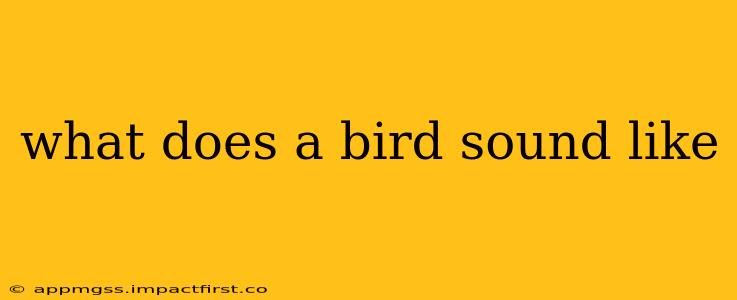What Does a Bird Sound Like? A Symphony of Feathers
The question, "What does a bird sound like?" is deceptively simple. The answer, however, is incredibly diverse and depends entirely on the species of bird. With over 10,000 bird species worldwide, the soundscape they create is a breathtakingly complex and beautiful tapestry of chirps, tweets, whistles, and songs. There's no single answer, but let's explore the variety and delve into some common sounds and the reasons behind them.
What are the different types of bird sounds?
Birds utilize a wide range of vocalizations, each serving a specific purpose. These sounds aren't just pretty melodies; they're vital for survival.
-
Songs: These are complex and often melodic vocalizations, primarily used by males to attract mates and defend territories. Think of the iconic dawn chorus – a vibrant symphony of competing songs from numerous bird species. Song complexity varies greatly; some are simple whistles, while others are elaborate sequences of notes and trills.
-
Calls: Calls are shorter, simpler sounds used for a variety of purposes, including contact calls (to maintain contact with other birds in a flock), alarm calls (to warn of danger), and begging calls (used by chicks to solicit food from parents). These are often less musical than songs.
-
Clicks and Chatters: Some birds, particularly those foraging in dense vegetation, use clicks and chatters as a form of communication. These sounds are often less melodic and more percussive.
-
Whistles: These are high-pitched, clear sounds frequently used in both songs and calls. Their clarity allows them to travel relatively long distances.
What are some examples of common bird sounds?
Describing bird sounds with words is challenging; the best way to understand them is to hear them. However, let's try to paint a picture with words:
-
Chirping: This is a common sound, often associated with small birds like sparrows, characterized by rapid, high-pitched, repetitive sounds.
-
Tweeting: Similar to chirping, but usually higher pitched and often less repetitive. Think of the sound of a small songbird in a garden.
-
Whistling: A clear, melodious sound, often associated with larger birds like blackbirds or robins.
-
Squawking: A loud, harsh sound, often associated with larger birds like crows or ravens.
-
Cooing: A soft, gentle sound, often associated with doves and pigeons.
Why do birds make different sounds?
The sounds birds make are crucial for their survival and reproduction. As mentioned, songs attract mates and defend territory, calls help maintain flock cohesion and warn of danger, and begging calls ensure chicks get the food they need. The specific sounds and their variations can even indicate the bird's emotional state or the presence of nearby predators.
How do birds produce these sounds?
Birds produce sounds using their syrinx, a specialized vocal organ located where the trachea (windpipe) splits into the lungs. Unlike human vocal cords, the syrinx can produce two sounds simultaneously, contributing to the complexity of bird songs. The shape and structure of the syrinx, along with the bird's beak and throat, influence the sound produced.
What factors influence the sound a bird makes?
Several factors influence a bird's vocalizations:
- Species: Different species have unique vocalizations.
- Sex: Males often sing more complex songs than females.
- Age: Young birds may have simpler vocalizations than adults.
- Season: Breeding season often brings a surge in complex songs.
- Environment: The surrounding environment can affect how a bird's sound travels.
Ultimately, the best way to answer "What does a bird sound like?" is to go outside and listen! Every bird species has its own unique voice, contributing to the incredible diversity of sounds in the natural world. Use bird identification apps or websites to help match sounds to species and further enhance your birding experience.
